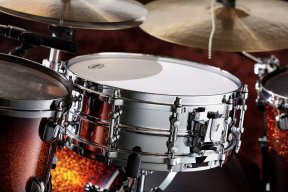I'm not a fan of prominent snare ring. Of course, "prominent" means something different to every player, so determining how much ring is too much is pretty personal from the outset. Nevertheless, here are a few suggestions for mitigating ring without applying ridiculous concentrations of tone-destroying muffling:
I. Play a wood snare -- though I believe that the Sonor snare in question is composed of maple, correct? In general, wood is warmer and drier than metal. Exceptions do exist, but wood produces less ring, ping, and honk than most metal snares I've encountered.
II. Try a batter head with built-in tone control, such as Remo's Coated Powerstroke 3. It's a single ply -- the same weight, in fact, as an Ambassador -- but it contains an overtone-reducing inlay ring. Ring and ping will be abated, but the inlay's influence isn't as drastic as that of an external device placed on top of the head.
III. Try a 2mil snare-side head. The thinner weight will dry out the sound. Both buzz and ring will be minimized.
I'm well-versed in the arguments for allowing ring to flourish. It transports sound to the audience, potentially augments the drum's presence in the mix, permits the drum to speak in an unhindered fashion, and so on. While all of that is true, when I'm in a mic'd setting, the audience receives sound just fine no matter how I'm tuned, and in an un-mic'd setting, I'm usually in a small venue where I'm not seeking maximum volume anyway. As for recording, no engineer has ever requested more ring from my drums -- exactly the opposite, if anything. A drier sound just makes sense in my case. Every case stands alone, however, and individual taste should be the deciding factor.


